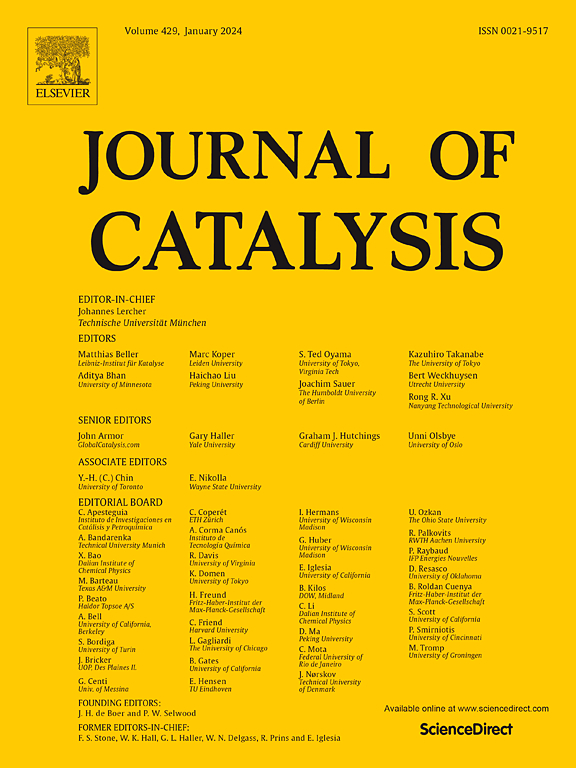异质金属掺杂的附加d电子增强了二维二硫化钼的电子扰动,促进了氢的高效析氢
IF 6.5
1区 化学
Q2 CHEMISTRY, PHYSICAL
引用次数: 0
摘要
过渡金属掺杂是一种成熟的策略来调节二维过渡金属二硫化物(TMD)的电子结构,以实现有效的电催化。通常,在二维TMD中掺杂的异质金属的氧化态是二价的,这限制了其对活性位点的电子摄动强度。因此,在二维TMD中引入低价异质金属是一种可行的策略,可以通过存在额外的d电子来增强电子扰动,从而产生新的电催化活性。作为概念验证,本工作通过“插层-硫化”将Co(0)引入MoS2 (Co(0)-MoS2)中。与Co(II)掺杂的MoS2 (Co(II)-MoS2)相比,Co(0)-MoS2中Co掺杂的额外d电子的存在促进了“Co- s - mo”原子之间的电子扰动,从而优化了MoS2活性位点的电子结构。结果表明,Co(0)-MoS2同时促进了电催化碱性HER的H2O解离和H*解吸,导致HER活性优于大多数mos2基催化剂(过电位:28 mV, 10 mA/cm2;塔菲尔斜率:47 mV/dec)。本文章由计算机程序翻译,如有差异,请以英文原文为准。


Additional d electron of heterometal dopant enhances electronic perturbation in 2D MoS2 for efficient hydrogen evolution
Transition metal doping is a well-established strategy to modulate the electronic structure of 2D transition metal dichalcogenide (TMD) for efficient electrocatalysis. Conventionally, the oxidation state of the heterometal doped in 2D TMD is divalent, which limited its electronic perturbation strength towards active sites. Therefore, introducing low-valent heterometal into 2D TMD is proposed to be a feasible strategy to enhance the electronic perturbation through the presence of additional d electrons, leading to novel electrocatalytic activity. As a proof of concept, Co(0) is introduced into MoS2 (Co(0)-MoS2) through “intercalation-vulcanization” in this work. Comparing to Co(II) doped MoS2 (Co(II)-MoS2), the presence of additional d electrons at Co dopant in Co(0)-MoS2 facilitated the electronic perturbation between “Co-S-Mo” atoms, which optimizes the electronic structure of the active sites at MoS2. As results, the H2O dissociation and H* desorption for electrocatalytic alkaline HER were simultaneously facilitated by Co(0)-MoS2, leading to HER activity superior to most of MoS2-based catalyst (overpotential: 28 mV at 10 mA/cm2; Tafel slope: 47 mV/dec).
求助全文
通过发布文献求助,成功后即可免费获取论文全文。
去求助
来源期刊

Journal of Catalysis
工程技术-工程:化工
CiteScore
12.30
自引率
5.50%
发文量
447
审稿时长
31 days
期刊介绍:
The Journal of Catalysis publishes scholarly articles on both heterogeneous and homogeneous catalysis, covering a wide range of chemical transformations. These include various types of catalysis, such as those mediated by photons, plasmons, and electrons. The focus of the studies is to understand the relationship between catalytic function and the underlying chemical properties of surfaces and metal complexes.
The articles in the journal offer innovative concepts and explore the synthesis and kinetics of inorganic solids and homogeneous complexes. Furthermore, they discuss spectroscopic techniques for characterizing catalysts, investigate the interaction of probes and reacting species with catalysts, and employ theoretical methods.
The research presented in the journal should have direct relevance to the field of catalytic processes, addressing either fundamental aspects or applications of catalysis.
 求助内容:
求助内容: 应助结果提醒方式:
应助结果提醒方式:


